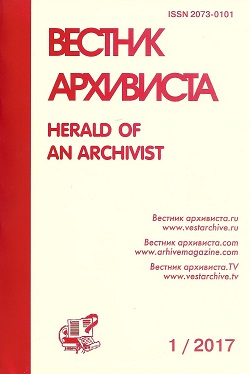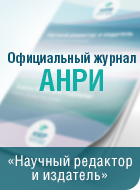Unrealized Project of “Demolition” of 26 Villages of the Moscow Region on Account of Functioning Orthodox Churches (1951)



Scientific article
УДК 94(47)+94(470.311)+930.253
DOI 10.28995/2073-0101-2022-2-546-556
Nikonov, Vadim V.
Russian State University for the Humanities, Moscow, Russian Federation
Unrealized Project of “Demolition” of 26 Villages of the Moscow Region on Account of Functioning Orthodox Churches (1951)
Abstract
The article analyses the document suggesting that in the early 1950s there were plans for a significant reorganization of the administrative division of the Moscow region at the highest state level. The work, based on the principles of historicism, systematicity, and objectivity, using comparative historical, problem-analytical, and problem-chronological methods of historical research, examines the letter of the plenipotentiary of the Council for the Affairs of the Russian Orthodox Church under the Council of Ministers of the USSR for the city of Moscow and the Moscow region A. A. Trushin to the deputy chairman of the Council S. K. Belyshev. Essentially, it proposed to abolish (the word “demolish” was used) 26 large villages, attaching them to the nearby villages, often smaller in size and population. The only exception was, as far as can be judged, the small village of Novaya Derevnya which was to become part of Pushkino, a large city and district center. The formal reason for this reorganization was “merger of kolkhozes and resettlement of some localities to central farmsteads of the kolkhozes.” The analysis of documents, as well as comparison of status and size of the villages suggested for the “resettlement” to the do called “central farmsteads,” disproves this. Meanwhile, true motives for such reorganization are obvious and cited quite unambiguously: “26 villages in which there are functioning churches are scheduled for demolition.” Naturally, villages (or town in case of Pushkino), to which the abolished villages were to be attached, had no functioning temples. Considering general vector of development of the relations between the Church and the state, the authors of the proposed merger had every reason to believe that new churches in the enlarged villages would never be built or restored. The document expressively demonstrates the true attitude of the Soviet government to the Russian Orthodox Church in the period, which is often and not without reason considered a time when anti-church pressure somewhat weakened, following the historic meeting of J. V. Stalin with three metropolitans in September 1943. There is no resolution on the letter of the plenipotentiary A. A. Trushin (at least on the copy with which the author of the article has worked), and we do not know its future fate. As for the plans it contains, they were never realized, as all villages, that were to be abolished on account of functioning Orthodox churches in 1951, can still be found on the map of the Moscow region.
Keywords
Source, archival document, S. K. Belyshev, Moscow region, merger of kolkhozes, Russian Orthodox Church, demolition of villages, Council for the Affairs of the Russian Orthodox Church, A. A Trushin.
Download the article: nikonov_doi
References
GORBUNOV, A. V. Gosudarstvo i religioznye organizatsii v SSSR (1940–1960- e gg.) v trudakh emigrantskikh i sovetskikh issledovatelei [State and religious organizations of the USSR (1940s–60s) in the works of emigrant and Soviet researchers. In Russ.]. IN: Vestnik KemGU, 2011, no. 2, pp. 10–12.
DAMASKIN (ORLOVSKY, V. A.), archimandrite. Kanonizatsiya svyatykh i psevdokanonizaysiya usopshikh podvizhnikov. Problemy i resheniya [Canonization of saints and pseudo-canonization of deceased ascetics. Problems and solutions. In Russ.]. IN: Istoriya i arkhivy, 2020, no. 3, pp. 69–86.
KAIL’, M. V. Pravoslavie v Rossii 1914–1964 godov: Opyt izucheniya i obshhestvennaya pamyat’ v diskurse repressii i poiske al’ternativnykh poznavatel’nykh podkhodov [Orthodoxy in Russia (1914–64): The experience of studying and public memory in the discourse of repression and search for alternative cognitive approaches. In Russ.]. IN: Novyi istoricheskii vestnik, 2021, no. 3, pp. 74–86.
MAZYRIN, A. V. Vopros o prizvanii sluzhitelei Tserkvi v epokhu gonenii: dva vzglyada sovremennikov [The question of vocation of the church ministers in the era of persecution: Two points of view of contemporaries. In Russ.]. IN: Vestnik PSTBU, 2011, no. 43, pp. 70–82.
MINTS, M. M., ROCCUCCI, A. Stalin i patriarkh: pravoslavnaya tserkov' i Sovetskaya vlast', 1917–1958 [Stalin and the Patriarch: The Orthodox church and the Soviet power, 1917–58. In Russ.]. IN: Sotsial'nye i gumanitarnye nauki. Otechestvennaya i zarubezhnaya literatura, 2017, no. 4, pp. 115–118.
NIKONOV, V. V., NOVAK, Vyacheslav, hier. Istoriya khrama vo imya Arkhistratiga Mikhaila i sela Konstantinovo Ramenskogo raiona Moskovskoi oblasti [History of the Archangel Michael church and the village of Konstantinovo of the Ramenskoye district of the Moscow region. In Russ.]. Moscow, Vysshaya shkola publ., 2014, 330 р.
NIKONOV, V. V., USHATOVA, N.P. Za Khrista preterpevshie. Tserkov' i politicheskie repressii 1920–1950-kh gg. na territorii Ramenskogo raiona Moskovskoi oblasti [Those who suffered for Christ: The Church and political repressions of the 1920s–1950s on the territory of the Ramenskoye district of the Moscow region. In Russ.]. Gzhel', GGU publ., 2016, 616 р.
About the authors
Nikonov Vadim Vadimovich, PhD in Pedagogics, Russian State University for the Humanities, department of history and organization of archiving, assistant professor, Moscow, Russian Federation, +7-495-250-61-18, +7-926-511-10-40, This e-mail address is being protected from spambots. You need JavaScript enabled to view it
Submitted 12.11.2021, published (for citation):
NIKONOV, V. V. Proekt “snosa” 26 selenii Moskovskoi oblasti iz-za deistvovavshikh v nikh pravoslavnykh khramov. 1951 g. [Unrealized Project of “Demolition” of 26 Villages of the Moscow Region on Account of Functioning Orthodox Churches (1951). In Russ.]. IN: Vestnik arhivista / Herald of an Archivist, 2022, no. 2, pp. 546-556. doi 10.28995/2073-0101-2022-2-546-556











